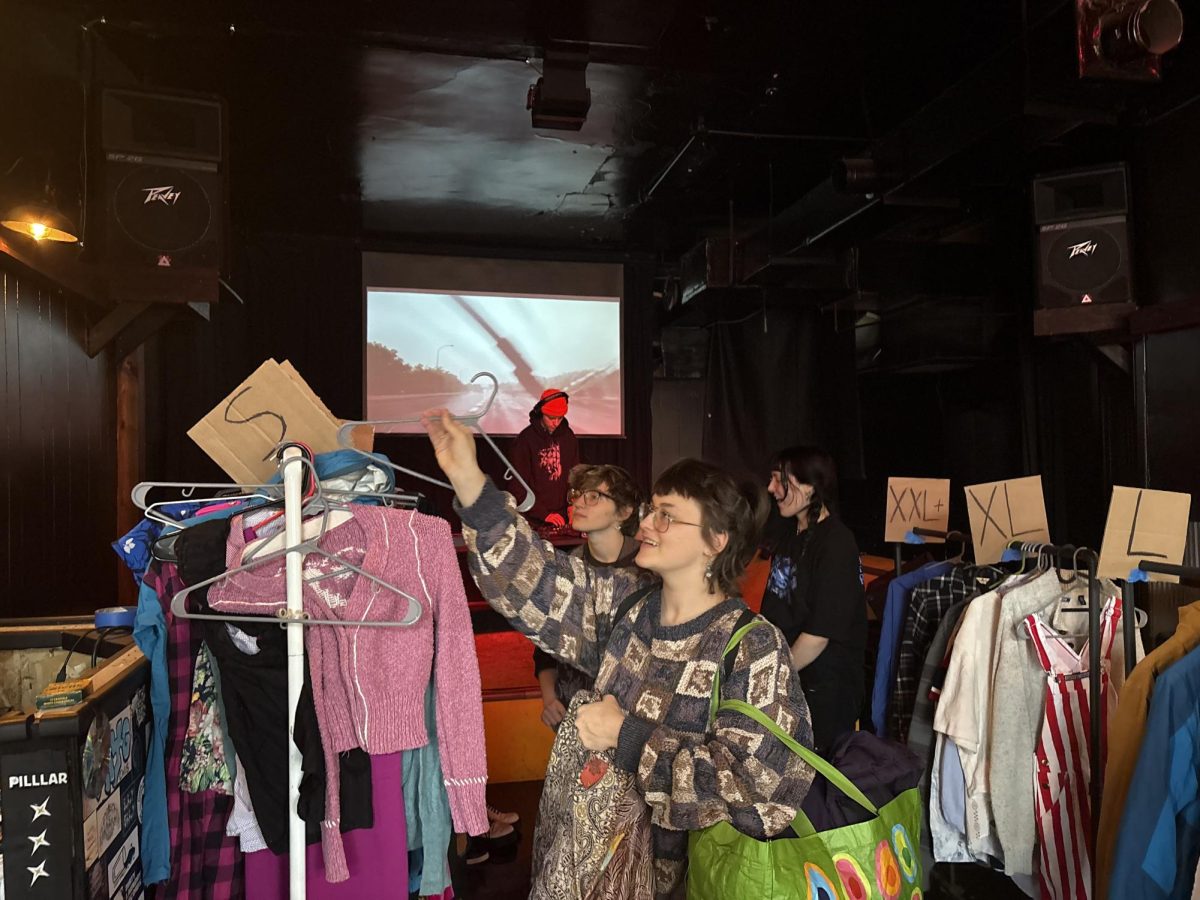Drag performer Esmé Rodríguez is perched before a green room mirror in Bryant Lake Bowl’s basement, donning fake black eyelashes, a quart of turquoise-encrusted eye shadow and obscenely large diamond chandelier earrings. As she teases the sculpted mass of red and blond tresses on top of her head, she sighs with satisfaction.
“The higher the hair, the closer to God,” Rodríguez said.
Soon, Rodríguez – who jokingly claims that glitter is her seventh food group – will emerge onstage to do a walk-through tech rehearsal.
“It’s not about where you start, but about bringing yourself to the high art of the drag queen. And it takes a lot of boobs and butts to get there,” she said as she straps on a gelatinous nude-hued brassiere.
Rodríguez, whose person behind the persona is a University Ph.D. candidate in Spanish and Portuguese studies with a focus in gender and performance theories, has been involved with the performing group “Dykes Do Drag” for five years.
Formed out of a diverse group of different races, sexual identities and genders, “Dykes Do Drag” is a hodge-podge clan of dancers, actors and artists. Through their cabaret-style performative whimsy, these avant-garde purveyors of drag-king culture complicate those silly little notions of butch/femme gender roles and drag stereotypes through their jazzy song and dance numbers.
The performance will dabble in an experimental medley of pieces: Among the performers are The Kings of Ramsey County’s rendition of “Macho Man” and “Johnny Are You Queer” (three Macalester seniors) Cocoa Puff and the North High Beaverettes.
But, even in the razzle-dazzle realm of drag-related debauchery and cross-dressing costumery, it’s still a man’s world.
Pop culture of the 20th century is filled with the beloved lore of lewd, shrewd and tart of tongue tyrannies. For years we’ve hit the Uptown Theater’s midnight showing of “The Rocky Horror Picture Show” just to sing along with Tim Curry’s outrageous character. And other gender-bending male performers, such as David Bowie, have been lavishly praised for their elegant androgyny. But, aside from a couple of “I Love Lucy” stints and Hilary Swank’s tragic transsexual character in “Boys Don’t Cry,” where are all the manly girls at?
A few women took notice of this lack of diversity in drag performative culture in 1999. Rudy Renaud, the then-editor of Lavender Magazine, booked a weekend slot at the Bryant Lake Bowl and asked Heather Spear to help coordinate the very first “Dykes Do Drag” piece.
The weekend was a rootin’ tootin’ success. Since then, Heather Spear (“The Gentleman King”) has led the group through many a male and female mimicry stints. The pieces are known for creating some complicated critiques and celebrations of gender ambiguity.
One performer, who was female identified, performed a song by George Michael in which she acted out the real George Michael (gay man) playing the stage George Michael (straight man).
Despite the fact that drag queen culture has been an important part of GLBT culture, one can’t help but wonder if the art of the drag queen show isn’t just the spectacle of male exhibitionism – Terrell Owens on the ball field with stilettos and a boa. The performance of masculinity, on the other hand, has to rely on the more subtle codes of the gender.
“In our culture, the cues for being a man are simple, but there are a lot more cues for being a woman,” Spear said. “Maleness seems to be kind of the control group. You’re a man unless you put on all these other things that signal you’re a woman.”
Drag has an obsession with the femme mystique. It is the quintessential flamboyant boy’s play-time dress up.
Performing as a man, however, is a completely different act. “Femininity is already accepted as being a performance to play on, to take to extremes, and it’s a lot easier than playing a male,” Spear said. “There’s more confidence and bravado involved. It tends to be a lot more flashy and shiny.”
Drag king culture – encompassing a diverse array from swashbuckling, slinky male characters, to gentlemanly, playboy types – is often concerned with representing not just a one-dimensional shade of spoon-fed hairy masculinity, but it seeks to tweak out the subtle shades of masculinity that are often marginalized in gender stereotyping.
“In popular assumptions about gender, there’s something called man and woman, and you’re either one or the other. If you don’t fit into one of the cultural constructs, you are marginalized or viewed as weird,” Spear said.







